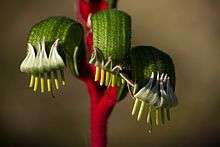Kangaroo paw

Kangaroo paw is the common name for a number of species, in two genera of the family Haemodoraceae, that are endemic to the south-west of Western Australia. These rhizomatous[1] perennial plants are noted for their unique bird attracting flowers. The tubular flowers are coated with dense hairs and open at the apex with six claw-like structures: from this paw formation the common name "kangaroo paw" is derived.[2]
The plant was named after the shape of the flowers, which resemble to the paws of a kangaroo. The kangaroo plant has been introduced into Japan and has been grown as a new ornamental crop mainly in Okinawa Island under a subtropical climate.[3]
History
The genus Anigozanthos' author was French botanist Jacques-Julian Houton de Labillardiere, who first collected the Kangaroo Paw in 1792 near Esperance. Red and green kangaroo paw was introduced to England in 1833, and was first described in 1836 by botanist David Don. The specific name manglesii is so named in honour of the first individual to raise the specimen from seed, Robert Mangles, which he did in his English garden. His experience with growing the specimen is recorded in letters to his brother James Mangles.[4]
The red and green kangaroo paw was adopted as the state emblem of Western Australia in a proclamation on 9 October 1960.[5] An image of red and green kangaroo paw was superimposed onto a view of Perth from a distance on a 5 pence stamp, issued 1 November 1962, commemorating the Seventh British Empire and Commonwealth Games which were in that year held in Perth. The stamp was designed by R. M. Warner. The red and green kangaroo paw was again included on a stamp on 10 July 1968, which were six cent stamps in a series of state floral emblems. It was designed by Nell Wilson.[4]
In 1990 there was disease found on the kangaroo paw plant in Okinawa. The unreported fungi, which associated the plant becoming very limp and wilt, was characterised by a discolouration of the plant leaving it a brown to black colour around the stalks, leaves and base of the plant. As the plant began to discolour over time, white cottony mycelia started to appear at the surface of the lesions and then the plant eventually died.[3]
Cultural aspect
The plant is native to south-western Australia, occurring naturally from the Murchison River in the North to Busselton and Mount Barker in the South, and Lake Muir to the East. It has been developed as a cut-flower crop in the United States, Israel and Japan. In Israel, plants are propagated from tissue culture imported from Australia and are then grown in unheated greenhouses in natural day conditions.[6] The plants have found their way to California and become popular among garden supply businesses there.[7]
Classification
From the genus Anigozanthos:
- Anigozanthos bicolor Endl. (little kangaroo paw)
- Anigozanthos bicolor ssp. bicolor (two-coloured kangaroo paw)
- Anigozanthos bicolor ssp. decrescens
- Anigozanthos bicolor ssp. exstans
- Anigozanthos bicolor ssp. minor
- Anigozanthos flavidus DC. (tall kangaroo paw)
- Anigozanthos gabrielae Domin (dwarf kangaroo paw)
- Anigozanthos manglesii D.Don (red-and-green kangaroo paw)
- Anigozanthos manglesii ssp. manglesii
- Anigozanthos manglesii ssp. quadrans
- Anigozanthos pulcherrimus Hook. (golden kangaroo paw)
- Anigozanthos rufus Labill. (red kangaroo paw)
- Anigozanthos viridis Endl. (green kangaroo paw)
- Anigozanthos viridis subsp. terraspectans Hopper (dwarf green kangaroo paw)
- Anigozanthos viridis subsp. metallica (metallic green kangaroo paw)
From the genus Macropidia:
- Macropidia fuliginosa (Hook.) Druce (black kangaroo paw)
See also
Additional species in the genus Anigozanthos exist. They resemble kangaroo paws, however, they are instead known as "cat's paws":
- Anigozanthos humilis (cat's paw)
- Anigozanthos humilis ssp. chrysanthus (Mogumber cat's paw)
- Anigozanthos humilis ssp. grandis (tall cat's paw)
- Anigozanthos kalbarriensis (Kalbarri cat's paw)
- Anigozanthos onycis (branched cat's paw)
- Anigozanthos preissii (Albany cat's paw)
References
- ↑ Churchill, Jennie (9 May 2003). "Fact Sheet: Kangaroo Paws". Gardening Australia. Retrieved 4 June 2017.
- ↑ http://www.mullamulladesigns.com/#!kangaroo-paw/zoom/c14ai/imagep1z. Missing or empty
|title=(help) - 1 2 Satou, Ichinoe, Fukumoto, Tezuka, & Horiuchi. (2001). Fusarium blight of kangaroo paw (anigozanthos spp.) caused by fusarium chlamydosporum and fusarium semitectum.Journal of Phytopathology, 149(3‐4), 203-206. doi:10.1046/j.1439-0434.2001.00588.x
- 1 2 "Red and Green Kangaroo Paw". Australian National Herbarium. Retrieved 4 June 2017.
- ↑ "Floral Emblems of Australia Proclamation". Australian National Herbarium. Retrieved 4 June 2017.
- ↑ Tsror (Lahkim), L., Hazanovsky, M., Mordechai‐Lebiush, S., Ben‐David, T., Dori, I., & Matan, E. (2005). Control of root rot and wilt caused by pythium myriotylum in kangaroo paw (anigozanthos). Journal of Phytopathology, 153(3), 150-154. doi:10.1111/j.1439-0434.2005.00944.x
- ↑ "San Marcos Growers >Kangaroo Paws Jump Into California Gardens". www.smgrowers.com. Retrieved 2017-09-24.
